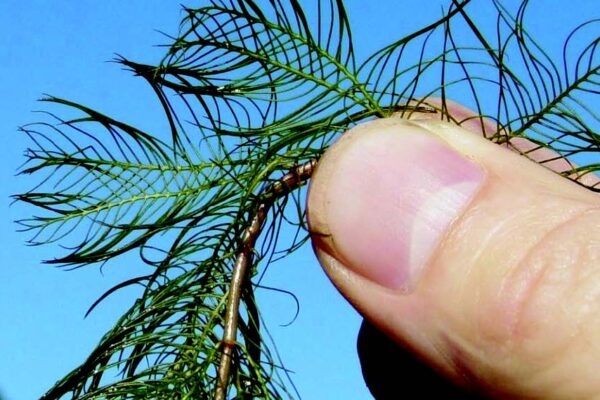Parrot Feather

Species at a Glance
Parrot feather (Myriophyllum aquaticum) gets its name from bright green, feather-like leaves which are whorled around the stem. It forms thick mats that choke waterbodies, impede recreation, and threaten the physical and chemical characteristics of Pennsylvania’s lakes and streams.
Species Description
Parrot feather has both submerged and emergent leaves that can extend up to 30 cm (12 in) above the water surface. Submerged leaves are more feathery and reddish, while emergent leaves are bright green. Leaves are often arranged in whorls of four to six around each node of the stem. The emergent green stem, which often looks like a fir tree, is its most identifying characteristic. When emergent stems and leaves are not present, parrotfeather may be confused with bladderworts, hornworts, and other leafy milfoils.
Native & Introduced Ranges
While its native range extends throughout most of South America, parrot feather was brought to the United States by the aquarium industry as a popular indoor and outdoor garden plant; possibly as early as the 1800s. After it escaped cultivation, most likely by release from an aquarium owner, it spread throughout the United States. In Pennsylvania, parrot feather has been found in north and south central and eastern counties.
Biology & Spread
Parrot feather has spread throughout the United States due to both human-mediated and natural processes. Human-mediated activities include intentional plantings by water gardeners, as well as unintentional spread by boating and other recreational activities. Only female plants are known to occur in the United States, therefore new plants grow through root division and plant fragments instead of by seed.
Since parrot feather is able to reproduce by fragmentation, bits of plant material stuck on boat motors or equipment can transfer it to new locations where it will form into a new plant. Parrot feather can also be spread by flooding, fragments stuck on birds or animals, and natural dispersal from plant fragments floating downstream.
Habitat
Parrot feather prefers shallow, nutrient-rich, and slow-moving water. It is most common in shallow water as a rooted plant, but can also be found as a floating plant in the deep waters of nutrient-enriched lakes. Parrot feather is adapted to waters with some salt and is able to colonize brackish coastal waterways.
Impacts
Threats to Biodiversity
While parrot feather may provide some cover for aquatic organisms, it has little food value for wildlife, and it severely alters characteristics of the aquatic environment. The dense stands fill the water column and shade out native plants and algae that serve as the basis of the aquatic food web. Large mats of parrot feather may trap sediments, causing sediment levels to increase and slow water flow. When these large mats die, their decomposition can create low oxygen conditions which may result in the death of fish and other aquatic organisms.
Economic Impact
The large mats that form in the water column have several economic impacts. They quickly fill waterways, impeding navigation and restricting recreational opportunities such as boating, fishing, and other water sports. The decreased recreational and aesthetic value can lead to decreases in surrounding lake property value. The sediment trapped by parrot feather can also block irrigation canals and impede water runoff, leading to flooding of adjacent lands.
Human Health
Parrot feather provides mosquito larvae habitat, offering a refuge from predation that may increase mosquito numbers and promote the spread of mosquito-borne diseases such as West Nile Virus.
Prevention & Control
Since parrot feather reproduces through plant fragments, physical removal and cutting will only increase its spread; therefore, it is not an effective control method. While some experts say parrot feather is not susceptible to herbicides, chemical control is also usually ineffective due to the thick and waxy cuticles of the leaves and stem, which prevents the penetration of chemical treatments. The best way to control parrot feather is to prevent its introduction and spread into new waterways. The following steps are provided to prevent the spread of aquatic invasive species:
- Check for and remove plants, mud, and aquatic life before transporting
- Drain water from boat, live well, bilge, and bait bucket before transporting
- Clean boat and gear with hot water, OR dry everything for at least five days.
References:
Maine center for Invasive Aquatic Plants & the Maine Volunteer Lake Monitoring Program. 2007. Maine
Field Guide to Invasive Aquatic Plants and their common native look alikes.
Wiedemer, S. & Chan, S. 2008. On the Lookout for Aquatic Invaders: Identification guide for the Pacific
Northwest. Oregon Sea Grant.
Global invasive species database. 2009. Parrotfeather (Myriophyllum aquaticum).



